| |
The Art of
Glassmaking
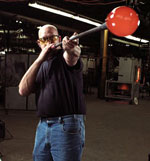 Glass is a
magical substance, caught somewhere in time between a solid and a liquid. It
is a demanding substance, requiring both confidence and abundant respect. Glass is a
magical substance, caught somewhere in time between a solid and a liquid. It
is a demanding substance, requiring both confidence and abundant respect.
To tame the
fire has long been a challenge for mankind, and the skillful creation of art
from glass may well be the most beautiful proof of accomplishing that dream.
The Fenton Art
Glass Company has been living this dream for over a century, remaining
true to times gone by, when quality and beauty were works of a man's hands,
and "faster" wasn't the only way.
Left
- A Fenton craftsman blows hot molten glass
|
Sculptor
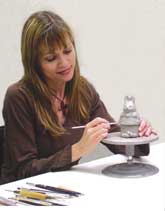 As
the sculptor at the Fenton Art Glass Co., Suzi Whitaker is on the
ground level of the century old business based in Williamstown. As
the sculptor at the Fenton Art Glass Co., Suzi Whitaker is on the
ground level of the century old business based in Williamstown.
"I create the shapes," maintains Whitaker.
"It all starts here," she adds.
"I come up with the mould," Whitaker explains.
Whitaker is adept at sculpting with both plaster and clay.
"I love to work with the clay," she notes. "With the plaster, I'm
carving with a knife and other sharp tools. With clay I can change
the mould with a brush of the finger," she says.
"Clay is the basis for Fenton's new moulds," continues Whitaker.
|
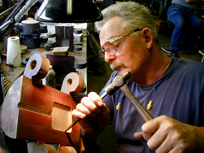 Mould Shop Mould Shop
Beginning with blank moulds cast from special high quality alloys and
using delicate chisels and files, the mouldmaker patiently carves the
intricate designs, some taking several months to complete this work.
Translating the designer's drawings and the sculptor's plaster and clay into the complex bold relief and
valleys of a finished mould requires great patience, skill and artistic
feeling. New moulds represent an investment of $20,000 or more.
|
The Ingredients
 The main ingredients and their approximate percentage of a Fenton batch
are: Sand (SiO2) 71%, Soda Ash (NaCO3) 15% and
Lime (CaCO3) 9%. Some manufacturers substitute potash for
soda ash, and barium or borax for lime. In some opaque glasses,
fluorspar and feldspar are substituted for The main ingredients and their approximate percentage of a Fenton batch
are: Sand (SiO2) 71%, Soda Ash (NaCO3) 15% and
Lime (CaCO3) 9%. Some manufacturers substitute potash for
soda ash, and barium or borax for lime. In some opaque glasses,
fluorspar and feldspar are substituted for
lime.
The color ingredients (5%) are mixed with the main ingredients before
melting.
|
|
Materials
Gold
Gold
Gold
Uranium
Cobalt
Sugar and
Iron |
Colors
Cranberry
Burmese
Rosalene
Yellow
Blue
Amber |
Materials
Neodymium or
Erbium
Iron or
Chromium
Manganese
Selenium and
Cadmium
Selenium and
Manganese
Alumina and Fluorine |
Colors
Pink
Green
Black
Orange
Crystal
Milk Glass |
|
Batch & Melting Process
Once the ingredients are mixed, they
are placed in a "pot" or "day tank" to melt at a temperature of about
2500 degrees F. The pots are inside a furnace which circulates flames
outside the pots but where no flame touches the glass. The day tank,
about three times the size of a pot, melts glass by fire directly on the
batch. It takes 24-30 hrs. for a pot melt and about 12 hours for a day
tank melt. |
Gatherer
This skilled worker winds hot molten glass on a hollow blow-pipe or the
tip of a long steel rod called a punty. He judges the proper amount of
glass to gather by the speed at which he turns the punty and the size of
its tip, so that each pieces of ware begins neither too heavy nor too
thin. He must also shape the gob properly and drop it precisely in the
center of the mould. |
Presser
Years of experience give the presser the sense of feel so vital to
making hand pressed glass. With his shears, the presser snips off the
molten glass dropped into the mould by the gatherer and smooths the cut
end to prevent a shear mark. He pulls the lever and holds it for just
the proper time to form the glass. Too much pressure and the glass will
shatter, too little and the mould will not fill properly.
|
Blower
(See photo top of
the page)
After the blocker has shaped, cooled and blown the first bubble of air
into the "gather" a carry over worker delivers the blowpipe with the gob
of glass to the blower. The blower reheats the glass in the glory hole
and rolls it on the flat steel marver plate to obtain a shape similar to
that of the mould. Standing on the traditional blower's platform, he
blows the hot glass into its final mould to form the basic shape and
pattern.
|
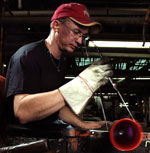 Finisher Finisher
The finisher, or "gaffer," forms the piece to its final shape using the
Pucellas (or "tool") and a cherry wood paddle, age-old implements of the
glassworker's art. Changing the shape by flaring, crimping, and/or
straightening, his sense of timing must be honed to a fine edge, for he
works the glass as it is on the threshold of becoming immovably chilled.
The tools and techniques used by Fenton's finishers have remained
essentially unchanged for nearly a century.
|
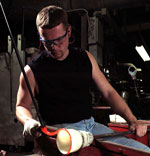 Ringer Ringer
Two techniques for which Fenton has become particularly famous are the
colored edge and distinctive crimping. The delicate ruffle of the crimp
and double crimp has earned Fenton a place of special recognition in the
art glass world. Only Fenton's most highly skilled craftsmen can spin an
edge of molten color on a piece that is about to be born.
|
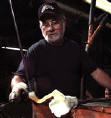 Handler Handler
Great skill is needed to put handles on baskets and pitchers. In about
25 seconds, the handler attaches a glowing ribbon of glass to a piece,
forms a loop and attaches the end. He works it into a graceful arch,
straight and true. The design on the stamp he uses to affix the handle
is his alone, and every Fenton handle can be traced to the craftsman who
created it. For more information on creating Fenton handles,
click here. To see a complete list of handlers' marks, including current
and retired, click
here. To read about Fenton's
first basket handler, Frank O. Myers,
click here.
|
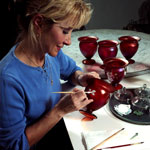 Hand Decorating Hand Decorating
Very careful procedures are used to choose the artists who handpaint
Fenton glass. A continuous training program is maintained to ensure high
standards for decorated ware. A mixture of enamel paints and finely
crushed glass is used in decorating. The piece is subjected to high
temperatures in a decorating lehr to ensure fusion of the paint to the
glass. Each piece is signed by the artist who painted it. For the
history of Fenton decorating a
list of decorators,
click
here.
|
Fenton Quality
The quality inspection of each piece of Fenton glass begins the moment
it is first formed in the hot metal department. Every worker assumes
responsibility for quality checking each piece. Fenton glass may be
checked as many as a dozen times before reaching the quality selector
who passes the final judgment. Each first-quality piece meets the high
standards required of Fenton handmade glass.
|